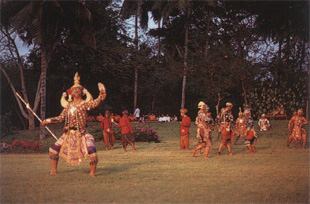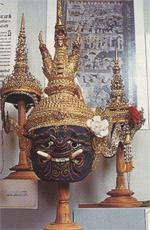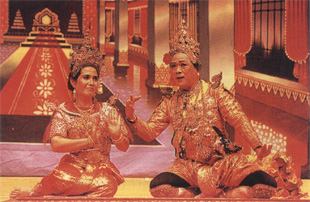|
|
|
The Arts
|
Khon
Khon productions were originally
so long more than 20 hours that
performances were staged on two
consecutive days. Indeed, a performance
of the entire Ramakien (with 311 chaacters) would take more than one month
720 hours plus) of continuous perfornance. King Rama it's shorter version
if the epic is used for dramatic purposes
nd contemporary adaptations of certain
nisodes are as short as three hours.

Khon, the classical Thai masked Drama
|
Lakhon dance drama is less formal
and actors, except for monkeys, ogres,
and other non-human, non-celestial
beings, do not wear masks. Lakhon
plots are drawn mainly from the
Ramakien. the Jatakas, and folk stories;
Khon and Lakhon costumes are identical,
but Lakhon dance rnovemenis are more
graceful, sensual, and fluid, the upper
torso and hands being particularly
expressive with conventionalized
movements portraying specific emotions.

Embroidered costumes are works of art in themselves
|
 |
Embroidered costumes are works of art in themselves
|
Lakhon is subdivided into numerous
variaiions, the major three being Lakhon
Chatri, Lakhon Nok, and Lakhon Nai.
Simplest of all in form and presentation,
Lakhon Chatri is often seen at popular
shrines, such as Bangkok's Lak Muang
(City Pillar) where dancers are hired by
supplicants whose wishes have been
granted to perform for the shrine deity.
Lakhon Nai drama was originally
presented only by court ladies in the
palace. It was graceful, romantic, and
highly stylized. Lakhon Nok plays, on
the other hand. were performed outside
the palace and acied only by men. Filled
with lively music, off-colour humour.
and rapid, animated movements,
Lakhon Nok was the ancestor of the
enormously popular Likay folk theatre
which is still a feature of many provincial festivals.

Full length perfonnances of the classical dance originally lusted for more than 20 hours.

Full length perfonnances of the classical dance originally lusted for more than 20 hours.
Likay, a burlesque of Lakhon
containing elements of pantomime,
comic folk opera, and social satire, is
generally performed against a simply
paimed background during temple fairs,
Its court-derived stories are embellished
with local references and anecdotes,
and spontaneous dialogue is full of
outrageous puns and double entendres.

Likay is a popular form of theatre often seen at festivals.
Two neglected dramatic forms
are Nang Yai shadow play and Hun
marionettes, both regular forms of
entertainment in Ayutthaya. In Nang Yai,
intricately fashioned cowhide Figures,
some two metres lall. are held against a
brilliant backlit white screen. Bearers
of the figures dance their parts, the
movements of which were later to provide
the pattern for Khon and Lakhon.
Shadow play figures, crafted from cowhide
Nang Talung, a more popular
shadow play found mainly in the south
of Thailand, closely resembles the
Indonesian Wayang. Beautifully fashioned
Nang Talung figures are smaller than
their Nang Yai counterparts and are
often constructed to have one moveabk
part an arm, a leg, or a chin. Concealed
from audiences, the manipulators are
skilled singers and comedians, whost
repartee keeps the action bubbling.
Thai marionettes, manipulated from below
Hun marionettes, seldom seen
today, are -superbly crafted figures which
differ from European marionettes in that
they are manipulated from below rather
than above. A more popular version is
Hun Krabok (literally, "cylindrical model") which are similar to Punch and
Judy-style hand puppets.

Dhadow play figures, crafted from cowhide
 |
Thai marionettes, manipulated from below Hun marionettes
|
| | |
|
|